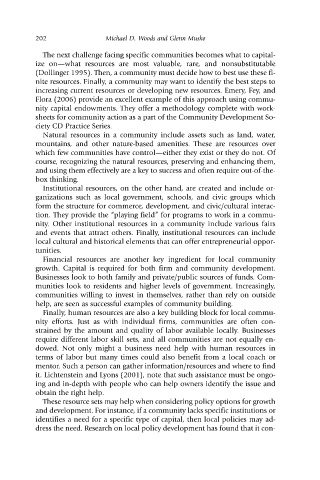Page 213 - 1-Entrepreneurship and Local Economic Development by Norman Walzer (z-lib.org)
P. 213
202 Michael D. Woods and Glenn Muske
The next challenge facing specific communities becomes what to capital-
ize on—what resources are most valuable, rare, and nonsubstitutable
(Dollinger 1995). Then, a community must decide how to best use these fi-
nite resources. Finally, a community may want to identify the best steps to
increasing current resources or developing new resources. Emery, Fey, and
Flora (2006) provide an excellent example of this approach using commu-
nity capital endowments. They offer a methodology complete with work-
sheets for community action as a part of the Community Development So-
ciety CD Practice Series.
Natural resources in a community include assets such as land, water,
mountains, and other nature-based amenities. These are resources over
which few communities have control—either they exist or they do not. Of
course, recognizing the natural resources, preserving and enhancing them,
and using them effectively are a key to success and often require out-of-the-
box thinking.
Institutional resources, on the other hand, are created and include or-
ganizations such as local government, schools, and civic groups which
form the structure for commerce, development, and civic/cultural interac-
tion. They provide the “playing field” for programs to work in a commu-
nity. Other institutional resources in a community include various fairs
and events that attract others. Finally, institutional resources can include
local cultural and historical elements that can offer entrepreneurial oppor-
tunities.
Financial resources are another key ingredient for local community
growth. Capital is required for both firm and community development.
Businesses look to both family and private/public sources of funds. Com-
munities look to residents and higher levels of government. Increasingly,
communities willing to invest in themselves, rather than rely on outside
help, are seen as successful examples of community building.
Finally, human resources are also a key building block for local commu-
nity efforts. Just as with individual firms, communities are often con-
strained by the amount and quality of labor available locally. Businesses
require different labor skill sets, and all communities are not equally en-
dowed. Not only might a business need help with human resources in
terms of labor but many times could also benefit from a local coach or
mentor. Such a person can gather information/resources and where to find
it. Lichtenstein and Lyons (2001), note that such assistance must be ongo-
ing and in-depth with people who can help owners identify the issue and
obtain the right help.
These resource sets may help when considering policy options for growth
and development. For instance, if a community lacks specific institutions or
identifies a need for a specific type of capital, then local policies may ad-
dress the need. Research on local policy development has found that it con-

